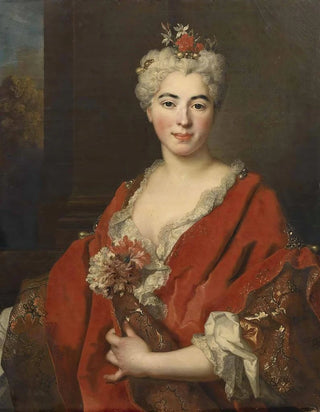Art print | Portrait of Marguerite Élisabeth De Largillière 1701-1756 The artist's daughter - Nicolas de Largillière


View from behind

Frame (optional)
Portrait of Marguerite Élisabeth De Largillière 1701-1756 The artist's daughter - Nicolas de Largillière – Captivating introduction
The portrait of Marguerite Élisabeth De Largillière, created by her father Nicolas de Largillière, is an iconic work that transcends the simple frame of a painting. This depiction, both intimate and public, of a young girl, daughter of the artist, immerses us in a universe where art and family life blend harmoniously. By capturing the very essence of his daughter, Largillière invites us to contemplate not only the face of a child but also the emotions and aspirations of a father. This painting, executed between 1701 and 1756, is a poignant testament to filial affection, as well as an illustration of the values and social conventions of its time.
Style and uniqueness of the work
Nicolas de Largillière's style is distinguished by his ability to combine realism and idealization. In this portrait, the delicate features of Marguerite Élisabeth are rendered with remarkable finesse, while the soft light illuminating her face creates an atmosphere of serenity. The artist uses warm colors and rich textures to bring his daughter to life, making every detail, from the fabric of her dress to the shine of her hair, highly sensual. This blend of realism and elegance gives the work a timeless dimension, where the viewer is invited to immerse themselves in the intimacy of the scene. Marguerite's pose, both natural and composed, demonstrates a perfect mastery of composition, allowing each element to harmoniously dialogue with the others.
The artist and his influence
Nicolas de Largillière, a major figure of portraiture in the 18th century, established himself as one of the most respected artists of his time. His career, marked by success, testifies to his skill in capturing the essence of his models, whether they come from nobility or the bourgeoisie. Largillière adapted to the evolving artistic tastes of his era while preserving his own vision. His influence extends beyond his work, as he also trained many students who continued

Matte finish

View from behind

Frame (optional)
Portrait of Marguerite Élisabeth De Largillière 1701-1756 The artist's daughter - Nicolas de Largillière – Captivating introduction
The portrait of Marguerite Élisabeth De Largillière, created by her father Nicolas de Largillière, is an iconic work that transcends the simple frame of a painting. This depiction, both intimate and public, of a young girl, daughter of the artist, immerses us in a universe where art and family life blend harmoniously. By capturing the very essence of his daughter, Largillière invites us to contemplate not only the face of a child but also the emotions and aspirations of a father. This painting, executed between 1701 and 1756, is a poignant testament to filial affection, as well as an illustration of the values and social conventions of its time.
Style and uniqueness of the work
Nicolas de Largillière's style is distinguished by his ability to combine realism and idealization. In this portrait, the delicate features of Marguerite Élisabeth are rendered with remarkable finesse, while the soft light illuminating her face creates an atmosphere of serenity. The artist uses warm colors and rich textures to bring his daughter to life, making every detail, from the fabric of her dress to the shine of her hair, highly sensual. This blend of realism and elegance gives the work a timeless dimension, where the viewer is invited to immerse themselves in the intimacy of the scene. Marguerite's pose, both natural and composed, demonstrates a perfect mastery of composition, allowing each element to harmoniously dialogue with the others.
The artist and his influence
Nicolas de Largillière, a major figure of portraiture in the 18th century, established himself as one of the most respected artists of his time. His career, marked by success, testifies to his skill in capturing the essence of his models, whether they come from nobility or the bourgeoisie. Largillière adapted to the evolving artistic tastes of his era while preserving his own vision. His influence extends beyond his work, as he also trained many students who continued






